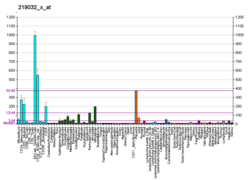OPN3

| OPN3 | |||||||||||||||||||||||||||||||||||||||||||||||||||
|---|---|---|---|---|---|---|---|---|---|---|---|---|---|---|---|---|---|---|---|---|---|---|---|---|---|---|---|---|---|---|---|---|---|---|---|---|---|---|---|---|---|---|---|---|---|---|---|---|---|---|---|
| Identifiers | |||||||||||||||||||||||||||||||||||||||||||||||||||
| Aliases | OPN3, ECPN, PPP1R116, opsin 3 | ||||||||||||||||||||||||||||||||||||||||||||||||||
| External IDs | OMIM: 606695; MGI: 1338022; HomoloGene: 40707; GeneCards: OPN3; OMA:OPN3 - orthologs | ||||||||||||||||||||||||||||||||||||||||||||||||||
| |||||||||||||||||||||||||||||||||||||||||||||||||||
| |||||||||||||||||||||||||||||||||||||||||||||||||||
| |||||||||||||||||||||||||||||||||||||||||||||||||||
| |||||||||||||||||||||||||||||||||||||||||||||||||||
| Wikidata | |||||||||||||||||||||||||||||||||||||||||||||||||||
| |||||||||||||||||||||||||||||||||||||||||||||||||||
Opsin-3 also known as encephalopsin or panopsin[4] is a protein that, in humans, is encoded by the OPN3 gene.[5][6][7] Alternative splicing of this gene results in multiple transcript variants encoding different protein isoforms.[8]
Function
[edit]Opsins are members of the G protein-coupled receptor superfamily. In addition to the visual opsins, mammals possess several photoreceptive non-visual opsins that are expressed in tissues outside the eye. The opsin-3 gene is strongly expressed in brain and testis and weakly expressed in liver, placenta, heart, lung, skeletal muscle, kidney, and pancreas. The gene is expressed in the skin[8] and may also be expressed in the retina. The protein has the canonical features of a photoreceptive opsin protein,[7] however in human skin, OPN3 is not photoreceptive and acts as a negative regulator of melanogenesis.[9]
Applications
[edit]When OPN3 analogues are expressed in neurons, activation by light inhibits neurotransmitter release.[10][11] This makes these analogues useful tools for optogenetic silencing, a method to study the impact of specific neurons on brain function.
References
[edit]- ^ a b c GRCm38: Ensembl release 89: ENSMUSG00000026525 – Ensembl, May 2017
- ^ "Human PubMed Reference:". National Center for Biotechnology Information, U.S. National Library of Medicine.
- ^ "Mouse PubMed Reference:". National Center for Biotechnology Information, U.S. National Library of Medicine.
- ^ Koyanagi M, Takada E, Nagata T, Tsukamoto H, Terakita A (March 2013). "Homologs of vertebrate Opn3 potentially serve as a light sensor in nonphotoreceptive tissue". Proceedings of the National Academy of Sciences of the United States of America. 110 (13): 4998–5003. Bibcode:2013PNAS..110.4998K. doi:10.1073/pnas.1219416110. PMC 3612648. PMID 23479626.
- ^ Blackshaw S, Snyder SH (May 1999). "Encephalopsin: a novel mammalian extraretinal opsin discretely localized in the brain". The Journal of Neuroscience. 19 (10): 3681–3690. doi:10.1523/JNEUROSCI.19-10-03681.1999. PMC 6782724. PMID 10234000.
- ^ Halford S, Freedman MS, Bellingham J, Inglis SL, Poopalasundaram S, Soni BG, et al. (March 2001). "Characterization of a novel human opsin gene with wide tissue expression and identification of embedded and flanking genes on chromosome 1q43". Genomics. 72 (2): 203–208. doi:10.1006/geno.2001.6469. PMID 11401433.
- ^ a b "Entrez Gene: OPN3 opsin 3 (encephalopsin, panopsin)".
- ^ a b Haltaufderhyde K, Ozdeslik RN, Wicks NL, Najera JA, Oancea E (January 2015). "Opsin expression in human epidermal skin". Photochemistry and Photobiology. 91 (1): 117–123. doi:10.1111/php.12354. PMC 4303996. PMID 25267311.
- ^ Olinski LE, Lin EM, Oancea E (January 2020). "Illuminating insights into opsin 3 function in the skin". Advances in Biological Regulation. 75: 100668. doi:10.1016/j.jbior.2019.100668. PMC 7059126. PMID 31653550.
- ^ Mahn M, Saraf-Sinik I, Patil P, Pulin M, Bitton E, Karalis N, et al. (May 2021). "Efficient optogenetic silencing of neurotransmitter release with a mosquito rhodopsin". Neuron. 109 (10): 1621–1635.e8. doi:10.1016/j.neuron.2021.03.013. PMC 7611984. PMID 33979634.
- ^ Copits BA, Gowrishankar R, O'Neill PR, Li JN, Girven KS, Yoo JJ, et al. (June 2021). "A photoswitchable GPCR-based opsin for presynaptic inhibition". Neuron. 109 (11): 1791–1809.e11. doi:10.1016/j.neuron.2021.04.026. PMC 8194251. PMID 33979635.
Further reading
[edit]- Bonaldo MF, Lennon G, Soares MB (September 1996). "Normalization and subtraction: two approaches to facilitate gene discovery". Genome Research. 6 (9): 791–806. doi:10.1101/gr.6.9.791. PMID 8889548.
- Halford S, Bellingham J, Ocaka L, Fox M, Johnson S, Foster RG, Hunt DM (2002). "Assignment of panopsin (OPN3) to human chromosome band 1q43 by in situ hybridization and somatic cell hybrids". Cytogenetics and Cell Genetics. 95 (3–4): 234–235. doi:10.1159/000059351. PMID 12063405. S2CID 24099335.
- Kasper G, Taudien S, Staub E, Mennerich D, Rieder M, Hinzmann B, et al. (July 2002). "Different structural organization of the encephalopsin gene in man and mouse". Gene. 295 (1): 27–32. doi:10.1016/S0378-1119(02)00799-0. PMID 12242008.
- Alam NA, Gorman P, Jaeger EE, Kelsell D, Leigh IM, Ratnavel R, et al. (December 2003). "Germline deletions of EXO1 do not cause colorectal tumors and lesions which are null for EXO1 do not have microsatellite instability". Cancer Genetics and Cytogenetics. 147 (2): 121–127. doi:10.1016/S0165-4608(03)00196-1. PMID 14623461.
This article incorporates text from the United States National Library of Medicine, which is in the public domain.


